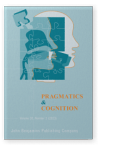Vol. 30:2 (2023) ► pp.296–329
On comprehending adjectival antonyms and negation
Revisiting negation as mitigation in Persian
This study explores the extent to which comprehending negated antonyms in Persian involves the mitigation effect, whereby a negated word means less than its antonym. In two mouse-tracking experiments, participants rated sentences containing negated/non-negated scalar (e.g., tall-short) and complementary (e.g., dead-alive) antonymous adjectives on a continuous scale. Their reaction times and mouse movements were recorded by MouseTracker. The analysis of reaction times shows that negated adjectives are processed slower than their affirmative counterparts. Moreover, the analysis of mouse trajectories shows that complementary adjectives are rated further apart, closer to the endpoints of the scale than scalar adjectives. We also found that both complementary and scalar adjectives are mitigated under negation, but the mitigation effect is greater in scalar, rather than complementary, adjectives. The results speak in favor of a particular kind of mitigation effect, so-called negative strengthening, which causes negated antonyms to receive a strong pragmatic interpretation towards the opposite member of the pair.
Article outline
- 1.Introduction
- 2.Background of the research
- 3.Aims, hypotheses and predictions
- 4.Method
- 4.1Materials
- 4.2Procedure
- 4.3Analyses
- 5.Experiment 1
- 5.1Participants
- 5.2Stimuli
- 5.3Results and discussion
- 6.Experiment 2
- 6.1Participants
- 6.2Stimuli
- 6.3Results and discussion
- 7.Exploratory analyses
- 7.1Combined experiments
- 7.2Testing the markedness hypothesis
- 8.Discussion
- 9.Conclusion
- Ethics statement
- Acknowledgment
- Notes
-
References
